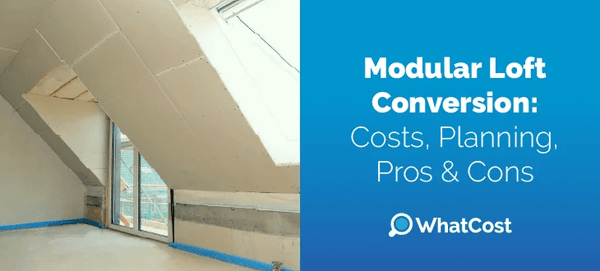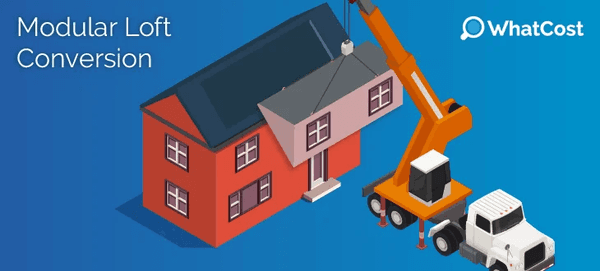Answer these simple questions and we will find you the BEST prices
Which type of solar quotes do you need?
It only takes 30 seconds
100% free with no obligation

Tell us what you need to find a matching loft conversion specialist

Get free quotes from professionals near you

Compare offers and choose the one that best matches your need
- whatcost.co.uk
- Loft Conversion
- Loft Conversion Types
- Modular Loft Conversion
Modular Loft Conversion: Costs, Planning, Pros & Cons


- Modular loft conversions are built with prefabricated modules assembled on-site.
- Modular loft conversions in the UK cost from £50,000 to £75,000. The final costs depend on design, materials, and added features like bathrooms.
- Modular lofts usually don’t require planning permission, but there are exceptions.
Expanding your home often comes with challenges—disruption to daily life, lengthy construction timelines, and the stress of managing unexpected costs. For many homeowners, these hurdles can make the idea of creating extra space seem daunting.
Modular loft conversions offer a great alternative, combining efficiency, speed, and predictability. Prefabricated modules are designed off-site and assembled quickly, minimising mess and inconvenience.
Whether you’re dreaming of an extra bedroom, a home office, or simply boosting your property’s value, this guide will walk you through the key details of modular loft conversion. Let’s dive in!
Ready to get your loft conversion done? Fill out our quick 30-second form to receive up to 3 no-obligation, free quotes from our network of trusted local installers specifically tailored to your project needs.
Click below to begin!
- Describe your needs
- Get free quotes
- Choose the best offer
It only takes 30 seconds



How does a prefab loft conversion work?
A prefab loft conversion, or modular loft conversion, involves creating a new loft space using prefabricated modules. These modules are constructed in a factory, transported to your site, and then assembled on your property.

Here’s how it works step by step:
- Site assessment: Professionals will visit your home to measure your loft to assess its structural integrity. They’ll check the roof's pitch, the load-bearing capacity of existing walls, and any access constraints for crane delivery.
- Design creation: Based on your requirements, architects from modular loft conversion companies will draft precise designs for the prefabricated modules, including insulation, plumbing, and electrical setups.
- Factory assembly: Once the designs are approved, the modules are constructed in a controlled factory environment.
- Structural reinforcement: Before the module arrives, your home may need reinforcements to support the additional load. This could include upgrading joists, beams, or existing walls.
- Roof removal: If the prefab loft will replace your roof, builders will carefully remove tiles and underlying materials while protecting the home from the weather.
- Transportation: The prefabricated modules are transported by truck to your home. For larger structures, modules may be split into sections for easier delivery.
- Craning the modules: A crane lifts the modules into position on top of your home. This step is fast, typically taking just one or two days to complete. The modules are aligned, secured, and bolted together seamlessly.
- Sealing and weatherproofing: Builders seal gaps between the modules and the existing structure to ensure weatherproofing. Roof tiles or cladding are adjusted or reinstalled to match your home’s exterior.
- Connecting utilities: Pre-installed plumbing, wiring, and HVAC systems are connected to your home’s existing infrastructure. This step ensures that water, electricity, and heating are fully functional.
- Internal finishes: Final touches like painting, flooring, and skirting boards are completed inside the loft. Additional features like built-in storage, lighting, and bathrooms are installed, if required.
- Building regulations compliance: Inspectors ensure the conversion meets UK building regulations for fire safety, insulation, and structural stability.
- Handover: Once all checks are complete, the loft is ready for use. You’ll receive documentation confirming compliance with regulations.
Within a matter of weeks (often less than traditional builds), your once-empty loft becomes a fully functional space.
This approach significantly reduces disruption to your daily routine. Unlike traditional methods, which often involve prolonged noise, dust, and construction crews in your home, modular loft conversions are completed quickly, with installation taking just a few days.
Modular loft conversion cost is set early. This minimises the risk of unexpected expenses common in traditional construction.
Modular loft conversion cost
Modular loft conversion costs between £50,000 and £75,000 in the UK. This estimate is based on an average cost of £1,800 to £2,500 per square metre. The final price depends on factors such as design complexity, material quality, and additional features like bathrooms or built-in storage.
Prefab construction offers predictable pricing due to its standardised manufacturing and installation processes. Unlike traditional builds, these processes reduce variability, ensuring consistent costs across projects.
However, there can be variations in the total cost of a modular loft conversion based on the cost of different loft conversion stages:
| Stage | Cost |
|---|---|
| Base conversion cost (basic structure and core materials of the loft module) | £40,000–£60,000 |
| Planning and building permits | £2,000–£5,000 |
| Transportation of modules and rental of cranes for installation | £3,000–£6,000 |
| Interior finishes and custom features | £10,000–£20,000 |
To get the best value for your modular loft conversion, it’s a smart idea to gather multiple quotes.
Different providers can vary in pricing, timelines, and what’s included, so comparing options helps you find the one that works best for your needs and budget.
Plus, having several quotes gives you a better sense of the market rate and lets you take advantage of competitive pricing, which can make a big difference in the cost and quality of your project.
Fill out our quick 30-second form to receive up to 3 no-obligation, free quotes from our network of trusted local installers specifically tailored to your project needs.
Click below to begin!
- Describe your needs
- Get free quotes
- Choose the best offer
It only takes 30 seconds



Is planning permission needed for a modular loft conversion?
Modular lofts are often considered permitted development loft conversions, which means you may not need planning permission if:
- The new loft doesn’t exceed the existing roof height.
- The total additional space is under 40m2 for a terraced house or 50m2 for a semi-detached or detached home.
- There’s no significant change to the front of your property or its overall appearance.
- You’re not in a conservation area or a listed building.
However, you’ll likely need planning permission if:
- The loft conversion includes a roof lift that raises the existing roofline.
- Your property is in a conservation area, national park, or is a listed building.
- The design significantly alters the exterior, such as large dormers facing the front or unusual materials.
- Local planning rules restrict permitted development.
To be sure, consult your local planning authority or a professional architect. They can confirm if your plans fall within permitted development or if an application is needed. It’s always better to check upfront to avoid delays or fines.
Types of homes ideal for modular loft conversions
Modular loft conversions work well for various types of homes, but some structural layouts and features make certain properties better suited for this construction method.
Let’s explore the best-suited house types:
- Detached homes offer the most freedom for ready-made loft conversions because they don’t share walls with neighbours. This eliminates concerns about party wall agreements, noise, or disrupting adjacent properties.
- Semi-detached homes strike a balance between flexibility and space. With only one shared wall, you still have considerable freedom in designing the modular loft while maintaining good neighbourly relations.
- Terraced homes are often compact and have limited scope for ground-floor extensions. Prefabricated modules can be designed to fit snugly into the existing roof structure without extensive on-site construction.
- Bungalows are one of the best candidates for modular loft conversions because of their expansive, often unused roof space. Converting a bungalow can add significant square footage by transforming it into a two-story home with multiple functional spaces.
- Properties with high roof pitches naturally provide more headroom in the loft space, reducing the need for significant structural changes. This makes installing prefabricated modules faster and more efficient.
- New-build homes are often constructed with modern materials and meet current structural standards, making them well-suited for modular additions.
- Chalet-style homes often feature steeply pitched roofs, creating ample vertical space for loft conversions. This design reduces the need for significant roof modifications, making modular installations more straightforward.
And here are house types to approach with caution while planning modular loft conversion:
- Listed buildings: Strict regulations often limit structural changes, including roof alterations and the use of modern materials. Prefabricated modules may not meet aesthetic or conservation requirements.
- Homes in conservation areas: Even if your home isn’t listed, conservation areas often impose restrictions on changes visible from the street. Dormer windows or roof lifts may not be approved.
- Flat roof properties: Flat roofs typically require additional structural reinforcement or even a roof redesign to accommodate prefabricated modules.
- Truss roof properties: Homes with truss roofs require significant structural modifications to create usable loft space, which can complicate and increase the cost of pre-built loft conversion. Consulting a professional is essential to assess whether the truss loft conversion is viable.
Modules need to be transported from the factory to your property, which can involve long-distance shipping. Oversized loads may require permits or escorts, depending on local regulations. Opt for a prefabrication company located closer to your property to reduce transportation challenges and costs.
Pros and cons of a prefabricated loft conversion
Let’s go over prefabricated loft conversion advantages to help you understand how its strengths align with your priorities:
- Faster construction: Off-site module construction significantly reduces on-site build time.
- Predictable costs: Fixed pricing minimises the risk of unexpected expenses.
- Less disruption: Most work is completed in a factory, limiting noise, mess, and delays at home.
- High precision: Factory-controlled conditions ensure consistent quality and precise measurements.
- Sustainability: Prefabrication generates less waste and reduces carbon emissions compared to traditional methods.
- Efficient installation: Modules can be craned into place in just a day or two.
- Customisable designs: Tailored options allow you to choose layouts, finishes, and features like bathrooms or storage.
- Market value growth: Investing in a loft conversion can lead to an increase in your property's market value by up to 20%, according to The Guardian.
To help you make the final decisions on future loft conversion easier, here are also the cons of prefabricated loft conversions:
- Higher initial cost: Prefabrication can be more expensive upfront than some traditional types of loft conversion.
- Access challenges: Craning modules into position requires adequate site access, which can be difficult in urban areas.
- Limited design flexibility: Prefabrication may not suit highly complex or unconventional designs.
- Planning restrictions: Homes in conservation areas or listed buildings may face stricter regulations.
- Structural adjustments: Older homes may require costly reinforcements to support the prefabricated modules.
- Transport logistics: Modules must be transported, which can complicate projects in hard-to-reach locations.
Is a modular loft conversion the right choice for you?
A modular loft conversion can be a fantastic solution if you're looking for a quick, efficient, and high-quality way to expand your living space. However, to ensure it's the best fit for your needs, it's crucial to explore all your options before committing to an installer.
Different providers can vary significantly in their pricing, timelines, and what’s included in the service. By obtaining multiple quotes, you can compare your options side by side, ensuring you get the best value for your money. This also helps you understand the market rate, negotiate better deals, and avoid unexpected costs down the line.
Take the time to request quotes from at least three reputable installers. This step not only helps you choose the right professional but also gives you the confidence that your project is in capable hands.
Start by filling out a simple form to get up to 3 no-obligation quotes from local specialists today. Click below to begin!
- Describe your needs
- Get free quotes
- Choose the best offer
It only takes 30 seconds



FAQ
A modular loft is a loft space created using prefabricated modules, built off-site, transported and assembled on your property.
In the UK, a modular loft conversion typically costs between £50,000 and £75,000, depending on size, design, and features.

Tania is an experienced writer with a keen interest in home improvement projects. Her motivation stems from a desire to help others create comfortable, functional, and aesthetically pleasing living spaces.
- Modular Loft Conversion: Costs, Planning, Pros & Cons
- How does a prefab loft conversion work?
- Modular loft conversion cost
- Is planning permission needed for a modular loft conversion?
- Types of homes ideal for modular loft conversions
- Pros and cons of a prefabricated loft conversion
- Is a modular loft conversion the right choice for you?
- FAQ
